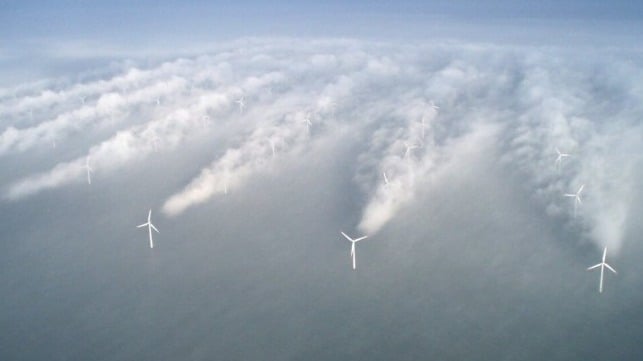Offshore "Wind Theft" Could Prompt Legal Conflicts Between Developers

Offshore wind farm developers already have to contend with rising costs and supply chain shortages, but in areas where the industry is expanding rapidly, they face a challenge after construction as well: "wind theft" by the next new installation built upwind.
In a new study, researchers from the University of Bergen's Offshore Wind Centre found that as the offshore wind industry grows in the North Sea, the interaction between wind farms' "wakes" - the disturbances that turbines create downwind - will increase markedly. Under the right conditions, wakes can stretch for up to 30 nautical miles, easily reaching into the territory of another wind farm. Without coordination, this risks reducing power generation efficiency, and it could even prompt cross-border tensions for farms on either side of a maritime boundary.
The effects of wind theft are often mutual. As the wind direction shifts, upwind and downwind installations trade places, so the unwanted wake interaction can affect both farms - or multiple farms, in areas where the developments are tightly clustered. Evaluations of the levelized cost of energy for wind farm financial planning have not always included this potential effect, even though it could have a real impact on a farm's output and earnings.
The new study examines the expected wake effects of the vast three gigawatt Sørlige Nordsjø II (SN2) wind farm, a proposed Norwegian lease area that borders on the Danish EEZ. It is 12 nm away from the planned Danish wind farm Nordsren III, close enough that "farm-induced wakes affect significantly the power production of both," the researchers found. The prevailing atmospheric conditions, wind direction and facility layout at SN2 are all likely to contribute to unwanted wake effect impacts and "wind theft" across the maritime boundary.
So far, there is no regulatory mechanism for resolving cross-border disputes over wind resources, noted the researchers, and wind does not follow manmade borders. In the absence of coordination, wind theft could easily prompt legal disputes between wind farm operators, or between coastal states. There is real money at stake, since wind farms cost billions to build and are financed with an expectation that they will produce a specific amount of power. When they produce less power than planned, the levelized cost of energy for the consumer goes up, and the economic competitiveness of the wind farm goes down.
The research team warned that this could also lead to a "rush to the water," in which coastal states expedite wind installations in order to get towers up before other states lay claim to wind resources.
Coordination between states - as is already often seen in the management of transboundary offshore oil and gas - would go a long way towards fending off conflict, the researchers proposed. One example is the German/Danish/Dutch/Belgian Esbjerg Declaration, in which the four nations agreed to jointly develop North Sea wind resources. A similar treaty was recently signed for Baltic waters.
"In times when our seas are liable to act as hubs for offshore wind development with the view of decarbonizing energy sectors, we must look beyond political aspirations and strive for regulatory solutions to wind theft in order to optimize resource management and thereby a more seamless energy transition," the team concluded.
